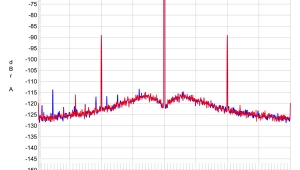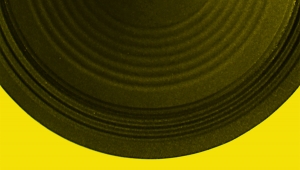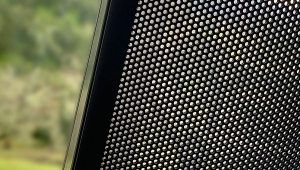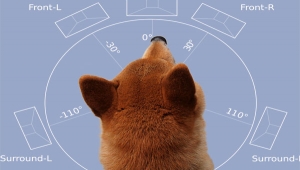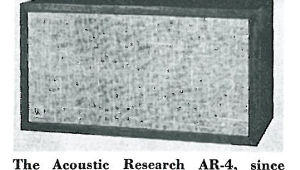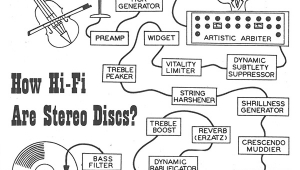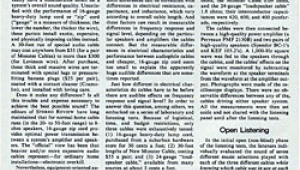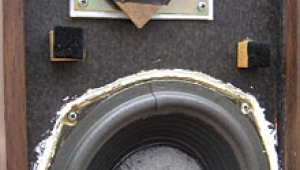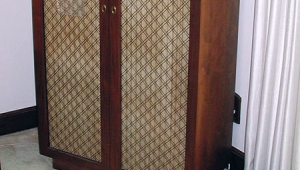| Columns Retired Columns & Blogs |
The Sound of Transistors KLH Model 16 amplifier
Sidebar 1: KLH Model 16 amplifier (from Vol.1 No.11, September 1965):
Specifications (furnished by manufacturer): Outputs: tape, speaker (8 ohms). Inputs (per channel): Mag phono; tape amp; 2 aux; tuner. Controls: Input (Phono, Aux 1, Aux 2, Tuner); ganged volume/loudness 1/loudness 2 switch; tape monitor switch; stereo/mono switch; filter switch; AC power. Power output: 35Wpc continuous, both channels operating. Harmonic distortion: <2%, 25Hz–20kHz at 35W, 8 ohm load. Frequency response: 25Hz–Hz +0, –1dB. Power bandwidth: 25Hz–20kHz. Hum and noise: 80dB below 35W output. Sensitivity (input for full output): Phono—2mV; Hi-level—300mV. Damping factor: 4.
Dimensions: 11¾" W by 4½" H by 10½" D.
Price: $219.95 (1965); no longer available (2006).
Manufacturer: KLH Research & Development Corp., 30 Cross Street, Cambridge, MA (1965).
This is a fully transistorized stereo amplifier with a rated dual-35-watt output (50Wpc IHFM). All controls are ganged, and the unit has a full complement of the usual ones, plus a treble filter whose action is quite effective without being unduly drastic. A three-position slide switch selects regular volume-control operation or a choice of two degrees of loudness compensation.
There are no input level-set controls, but two slide switches at the rear of the chassis allow the phono input sensitivity to be attenuated by 10dB, or the Aux 1 input to be attenuated by either 6½ or 13dB. The balance control has enough range to completely kill either channel in its extreme positions, and the tone controls too have a very wide range of control—so much, in fact, that it is necessary to keep them very accurately set to their Flat positions in order to maintain subjectively flat response. As a final fillip of flexibility, the KLH 16 has a front-panel Tape Monitor switch that makes it possible to monitor from the playback head of a three-headed recorder while taping.
The tape output is at fairly high impedance: 47k ohms plus the impedance of whatever is feeding the input selector switch. (The phono preamp feeds a very low impedance to it.) Consequently, the shielded cables running from the Tape Outputs to the recorder should be kept fairly short, with 6' as a safe maximum. Longer cables will attenuate highs in the signal going to the recorder.
The back of the amplifier comes with an important-looking red cautionary tag attached to it, warning against the interconnection of the output and phono input grounds. These are "floating" circuits—isolated from the chassis ground—and improper connections will upset the circuit parameters, causing distortion and possibly inducing damaging oscillation. This means, among other things, that the speakers should not be connected via any of the popular stereo speaker-switching devices (which use a common ground), and that grounding circuits from the turntable must be kept isolated from the signal ground returns from the arm. A separate grounding screw is provided at the rear of the chassis for separate arm and motor ground connections.
We tested two Model 16 amplifiers, one an early production unit, the other a refined version that went into production around mid-1964. The first unit met or exceeded its published specifications, but it had excessive hiss in its phono preamp stage, its tone controls did not yield flat response in their Flat positions (the errors amounted to about 2dB at 50Hz and 10kHz), the two halves of the volume control tracked very poorly (with a 10dB difference at some settings below 10 o'clock), and the sound was quite gritty at low volume levels.
The second sample was just as good in the specs department, and had virtually none of the problems of the earlier unit. Response and power output checks (both channels driven) verified the manufacturer's claims, as did noise measurements. As is customary, the noise spec is referred to full power output, presumably with the volume control all the way down. The acid test for transistorized components, and one which most of them fail miserably, is the noise measurement through the phono preamp stage, relative to a given level of input signal. Our second sample Model 16 measured 47dB down in one channel and 50dB down in the other, relative to a 10mV, 1kHz input. All of this noise was hiss, and it was low enough that it was barely audible through a speaker of typically low efficiency with the gain wide open and one ear right in front of the speaker.
Frequency response, with the tone controls set for Flat response, was as shown in fig.1. IM distortion (60Hz and 6kHz, SMPTE) was considerably lower at moderate power levels than that of most comparable transistor amplifiers, but at no time did it go as low as it does in the better tube-type amplifier-preamp combinations. IM in both channels hit 0.5% at around 15 watts, and then rose gradually to a bit over 1% as the output power dropped to 0.5 watts. At average listening levels of 5 watts and above (fairly high volume through most speakers), IM was comparable to that of a typical, good tube amplifier. Note that the above distortion figures were with an 8-ohm load. With 4 or 16 ohms, max output dropped to about 30 watts and, with 4 ohms, distortion started to rise sharply at output levels of more than 12 watts.
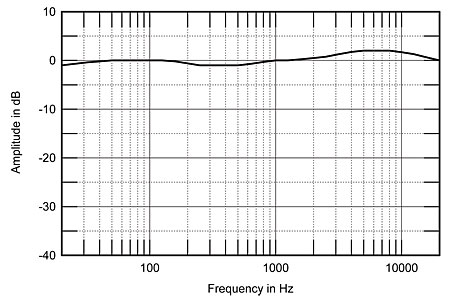
Fig.1 KLH Model 16, small-signal frequency response (5dB/vertical div.)
Volume control tracking in the second sample was within 1½dB, which is as good as anything we've found to date. Through its working range of 11 to 4 o'clock, channel balance did not vary beyond 1dB. This is a closer tolerance than volume-control manufacturers will guarantee, so if our sample was typical (which it may or may not be), we can only conclude that somebody is hand-picking the volume pots.
The Model 16 looks and handles like a precision instrument. Controls have the smooth, solid feel of expensive equipment, and only the presence of those infernal slide switches (which almost invariably become intermittent with frequent use in audio circuits) mar an otherwise luxurious "image."
Sonically, the most significant thing (to us) about the KLH 16 is that it sounds less "transistor" and more high-quality "tube" than any medium-priced solid-state unit we have heard. In comparison with top-grade tube equipment, it was very slightly bass-heavy (for reasons which escape us) and a little brilliant, the latter quality doubtless stemming from the slightly elevated shelf in the frequency response above 1kHz. At moderate to high listening levels, it had that quality of effortlessness and tight control that we've observed in other good transistor amplifiers, but it had less of the gritty "transistor sound" than any competitively priced unit we've heard. At low listening levels, with highly revealing speakers (electrostatic tweeters), the slight rise in residual distortion was evident as a subtle overlay of fine, sharp-pointed "whiskers" riding on the treble components of musical sound, but these were almost totally inaudible on the four other speaker systems we tried, all of them with dynamic-type high-frequency speakers.
Direct, hairsplitting comparisons between the Model 16 and topnotch tube equipment showed the 16 to have a shade less transparency, but we have yet to find another ready-built amplifier in its price and power range that will equal it. A Dynaco Stereo 70 and PAS3, for instance, costs $20 more in ready-built form ($70 less in kit form), and will provide a comparable level of performance at all but the lower end of the power range, where the Dyna is free from the Model 16's subtle fuzziness.
The Model 16's power capacity is the same as that of the Dyna Stereo 70, but like most transistor amps, the Model 16 seems able to put out more sheer power without audible overload than does the Dyna, at least when operated into an 8-ohm load. With a 16-ohm load, they both deliver about the same amount of clean output, but the Dyna has it all over the Model 16 for driving 4-ohm low-efficiency speakers.
At present, we would still pick the Dyna (or Marantz) for driving high-definition speakers like electrostatics and ionic-tweeter systems, but for most other loudspeakers we would judge the KLH 16 to be the best thing we've found to date at the price.—J. Gordon Holt
- Log in or register to post comments

